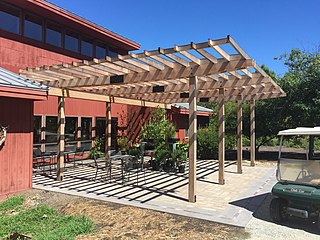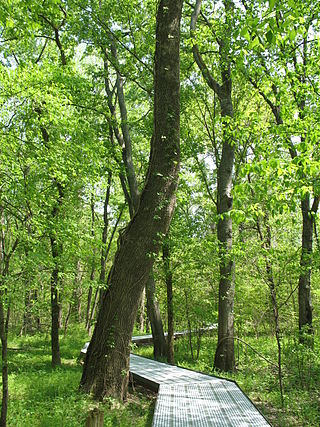
The Black River is a tributary of the Cape Fear River, approximately 50 mi (80 km) long, in southeastern North Carolina in the United States.
Mountain Top Arboretum, located in Tannersville, New York, United States is located in New York's Catskill Mountains.

Taxodium distichum is a deciduous conifer in the family Cupressaceae. It is native to the southeastern United States. Hardy and tough, this tree adapts to a wide range of soil types, whether wet, salty, dry, or swampy. It is noted for the russet-red fall color of its lacy needles.

The North Carolina Arboretum is an arboretum and botanical garden located within the Bent Creek Experimental Forest of the Pisgah National Forest at 100 Frederick Law Olmsted Way, southwest of Asheville, North Carolina near the Blue Ridge Parkway. It is open daily except for Christmas Day. There is no admission charge, but some parking fees do apply.

The Francis Beidler Forest is an Audubon wildlife sanctuary in Four Holes Swamp, a blackwater creek system in South Carolina, United States. It consists of over 18,000 acres (73 km²) of mainly bald cypress and tupelo gum hardwood forest and swamp with approximately 1,800 acres (7 km2) of old-growth forest. It is the largest virgin stand of cypress-tupelo forest in the world, with some Bald Cypress trees over 1,000 years old. It is a favorite haunt of birdwatchers and is used for biological research projects by area schools.

Adkins Arboretum is a 400-acre native garden and arboretum located within Tuckahoe State Park at 12610 Eveland Road, Ridgely, Maryland. The grounds contain five miles of paths through meadows and native plant gardens on the Eastern Shore of Maryland. Its gardens contain a "living collection" of more than 600 species of native shrubs, trees, wildflowers and grasses, used to promote land stewardship practices in the Chesapeake Bay region.

The southeastern myotis is a small bat found throughout the Gulf Coastal Plain and the Lower Mississippi Alluvial Plain of the southeastern United States.

The Croatan National Forest is a U.S. National Forest, was established on July 29, 1936, and is located on the Atlantic coast of North Carolina. It is administered by the United States Forest Service, a part of the United States Department of Agriculture. The forest is managed together with the other three North Carolina National Forests from common headquarters in Asheville, North Carolina. However, Croatan has a local ranger district office in New Bern.
The Boeuf Wildlife Management Area is 51,000-acre (210 km2)s of bottomland hardwoods, cypress-tupelo swamp, and other wetland habitats in northeast Louisiana. It is owned by the Louisiana Department of Wildlife and Fisheries. Boeuf Wildlife Management Area is located in Caldwell and Catahoula Parishes, near the city of Columbia, Louisiana.

Black Bayou Lake National Wildlife Refuge is one of five refuges managed in the North Louisiana Refuge Complex and one of 545 refuges in the National Wildlife Refuge System. It was established in 1997 through a unique partnership with the city of Monroe, Louisiana. The U.S. Fish and Wildlife Service has a free 99-year lease to manage the city-owned lake.
D'Arbonne National Wildlife Refuge is a National Wildlife Refuge of the United States located north of West Monroe, Louisiana. It is in Ouachita and Union Parishes on either side of Bayou D'Arbonne near its confluence with the Ouachita River. It lies on the western edge of the Mississippi River alluvial valley. It was established in 1975 to protect bottomland hardwoods and provide wintering habitat for migratory waterfowl. D'Arbonne is one of four refuges managed in the North Louisiana Refuges Complex.
Lake Ophelia National Wildlife Refuge was established in 1988 to protect the Mississippi/Red River floodplain ecosystem. The refuge is located in Avoyelles Parish, Louisiana, east central Louisiana. The refuge is named for its most prominent water body, the 350-acre (1.4 km2) Lake Ophelia that was at one time a channel of the nearby Red River of the South.

Village Creek State Park is a state park in the Piney Woods of eastern Texas in the Hardin County city of Lumberton. The heavily forested, 2,466 acres (998 ha) park opened in 1994. It is named for Village Creek, a sand-bottomed, free-flowing tributary of the Neches River.

The bottomland hardwood forest is a type of deciduous and evergreen hardwood forest found in broad lowland floodplains along large rivers and lakes in the United States and elsewhere. They are occasionally flooded, which builds up the alluvial soils required for the gum, oak and bald cypress trees that typically grow in this type of biome. The trees often develop unique characteristics to allow submergence, including cypress knees and fluted trunks, but can not survive continuous flooding.

Roanoke River National Wildlife Refuge was established in 1989 to protect and enhance wooded wetlands consisting of bottomland hardwoods and swamps with high waterfowl value along the Roanoke River. The extensive bottomland hardwood habitat of the Roanoke River National Wildlife Refuge is part of what the Nature Conservancy calls "one of the last great places."

Coniferous swamps are forested wetlands in which the dominant trees are lowland conifers such as northern white cedar. The soil in these swamp areas is typically saturated for most of the growing season and is occasionally inundated by seasonal storms or by winter snow melt.

The Middle Atlantic coastal forests are a temperate coniferous forest mixed with patches of evergreen broadleaved forests along the coast of the southeastern United States.

The Southeastern conifer forests are a temperate coniferous forest ecoregion of the southeastern United States. It is the largest conifer forest ecoregion east of the Mississippi River. It is also the southernmost instance of temperate coniferous forest within the Nearctic realm.
Patricia Jackson DeCoursey was a leading researcher in the field of chronobiology. Her research focused on behavioral, physiological, and ecological aspects of mammalian circadian rhythms. She is credited with creating the first Phase Response Curve (PRC). PRC’s are used throughout the field today to help illustrate the change of a biological oscillation in response to an external stimulus. She worked as a biology professor at the University of South Carolina (USC) from 1967 until her retirement as director of the W. Gordon Belser Arboretum in 2019.



















